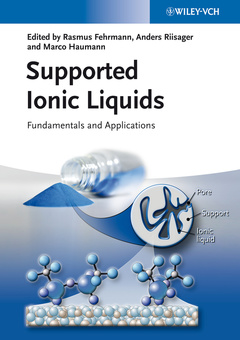Description
Supported Ionic Liquids
Fundamentals and Applications
Coordinators: Fehrmann Rasmus, Riisager Anders, Haumann Marco
Language: English
Subject for Supported Ionic Liquids:
496 p. · 17x24.6 cm · Hardback
Description
/li>Contents
/li>Biography
/li>
This unique book gives a timely overview about the fundamentals and applications of supported ionic liquids in modern organic synthesis. It introduces the concept and synthesis of SILP materials and presents important applications in the field of catalysis (e.g. hydroformylation, hydrogenation, coupling reactions, fine chemical synthesis) as well as energy technology and gas separation. Written by pioneers in the field, this book is an invaluable reference book for organic chemists in academia or industry.
INTRODUCTION
A Century of Supported Liquids
Supported Ionic Liquids
Applications in Catalysis
Applications in Separation
Coating of Heerogeneous Catalysts
Monolayers of IL on Surfaces
Conclusion
PART I: Concept and Building Blocks
INTRODUCING IONIC LIQUIDS
Introduction
Preparation
Liquid Range
Structures
Physical Properties
Effects of Ionic Liquids on Chemical Reactions
Ionic Liquids as Process Solvents in Industry
Summary
POROUS INORGANIC MATERIALS AS POTENTIAL SUPPORTS FOR IONIC LIQUIDS
Introduction
Porous Materials -
An Overview
Silica-Based Materials -
Amorphous
Layered Materials
Ordered Mesoporous Materials
Structured Supports and Monolithic Materials
Conclusions
SYNTHETIC METHODOLOGIES FOR SUPPORTED IONIC LIQUID MATERIALS
Introduction
Support Materials
Preparation Methods for Supported Ionic Liquids
Summary
PART II: Synthesis and Properties
PORE VOLUME AND SURFACE AREA OF SUPPORTED IONIC LIQUIDS SYSTEMS
Example I: [EMIM][NTf2] on Porous Silica
Example II: SCILL Catalyst (Commercial Ni catalyst) Coated with [BMIM][OcSO4]
TRANSPORT PHENOMENA, EVAPORATION, AND THERMAL STABILITY OF SUPPORTED IONIC LIQUIDS
Introduction
Diffusion of Gases and Liquids in ILs and Diffusivity of ILs in Gases
Thermal Stability and Vapor Pressure of Pure ILs
Vapor Pressure and Thermal Decomposition of Supported ILs
Outlook
IONIC LIQUIDS AT THE GAS-LIQUID AND SOLID-LIQUID INTERFACE -
CHARACTERIZATION AND PROPERTIES
Introduction
Characterization of Ionic Liquid Surfaces by Spectroscopic Techniques
Orientation and Properties of Ionic Liquids at the Solid-Liquid Interface
Comments
SPECTROSCOPY ON SUPPORTED IONIC LIQUIDS
NMR-Spectroscopy
IR Spectroscopy
A PRIORI SELECTION OF THE TYPE OF IONIC LIQUID
Introduction and Objective
Methods
Usage of COSMO-RS to Predict Solubilities in IL
Results of Reaction Modeling
Perspectives of the A Priori Selection of ILs
PART III: Catalytic Applications
SUPPORTED IONIC LIQUIDS AS PART OF A BUILDING-BLOCK SYSTEM FOR TAILORED CATALYSTS
Introduction
Immobilized Catalysts
Supported Ionic Liquids
The Building Blocks
Catalysis in Supported Thin Films of IL
Supported Films of IL in Catalysis
Advantages and Drawbacks of the Concept
Conclusions
COUPLING REACTIONS WITH SUPPORTED IONIC LIQUID CATALYSTS
Introduction
A Short History of Supported Ionic Liquids
Properties of SIL
Application of SIL in Coupling Reactions
Conclusion
SELECTIVE HYDROGENATION FOR FINE CHEMICAL SYNTHESIS
Introduction
Selective Hydrogenation of Alpha,Beta-Unsaturated Aldehydes
Asymmetric Hydrogenations over Chiral Metal Complexes Immobilize3d in SILCAs
Conclusions
HYDROGENATION WITH NANOPARTICLES USING SUPPORTED IONIC LIQUIDS
Introduction
MNPs Dispersed in ILs: Green Catalysts for Multiphase Reactions
MNPs Immobilized on Supported Ionic Liquids: Alternative Materials for Catalytic Reactions
Conclusions
SOLID CATALYSTS WITH IONIC LIQUID LAYER (SCILL)
Introduction
Classification of Applications of Ionic Liquids in Heterogeneous Catalysis
Preparation and Characterization of the Physical Properties of the SCILL Systems
Kinetic Studies with SCILL Catalysts
Conclusions and Outlook
SUPPORTED IONIC LIQUID PHASE (SILP) MATERIALS IN HYDROFORMYLATION CATALYSIS
SILP Materials in Liquid-Phase Hydroformylation Reactions
Gas-Phase SILP Hydroformylation Catalysis
SILP Combined with scCO2 -
Extending the Substrate Range
Continuous SILP Gas-Phase Methanol Carbonylation
Conclusion and Future Potential
ULTRALOW TEMPERATURE WATER-GAS SHIFT REACTION ENABLED BY SUPPORTED IONIC LIQUID PHASE CATALYSTS
Introduction to Water-Gas Shift Reaction
Challenges
SILP Catalyst Development
Building-Block Optimization
Application-Specific Testing
Conclusion
BIOCATALYTIC PROCESSES BASED ON SUPPORTED IONIC LIQUIDS
Introduction and General Concepts
Biocatalysts Based on Supported Ionic Liquid Phases (SILPs)
Biocatalysts Based on Covalently Supported Ionic Liquid-Like Phases (SILLPs)
Conclusions/Future Trends and Perspectives
SUPPORTED IONIC LIQUID PHASE CATALYSTS WITH SUPERCRITICAL FLUID FLOW
Introduction
SILP Catalysis
PART IV: Special Applications
PHARMACEUTICALLY ACTIVE SUPPORTED IONIC LIQUIDS
Active Pharmaceutical Ingredients in Ionic Liquid Form
Solid-Supported Pharmaceuticals
Silica Materials for Drug Delivery
Factors That Influence the Loading and Release Rate of Drugs
SILPs Approach for Drug Delivery
Conclusions
SUPPORTED PROTIC IONIC LIQUIDS IN POLYMER MEMBRANES FOR ELECTROLYTES OF NONHUMIDIFIED FUEL CELLS
Introduction
Protic ILs as Electrolytes for Fuel Cells
Membrane Fabrication Including PIL and Fuel Cell Operation
Proton Conducting Mechanism during Fuel Cell Operation
Conclusion
GAS SEPARATION USING SUPPORTED IONIC LIQUIDS
SILP Materials
Supported Ionic Liquid Membranes (SILMs)
Conclusion
IONIC LIQUIDS ON SURFACES -
A PLETHORA OF APPLICATIONS
Introduction
The Influence of ILs on Solid-State Surfaces
Layers of ILs on Solid-State Surfaces
Selected Applications
Sensors
Electrochemical Double Layer Capacitors (Supercapacitors)
Dye Sensitized Solar Cells
Lubricants
Synthesis and Dispersions of Nanoparticles
PART V: Outlook
OUTLOOK -
THE TECHNICAL PROSPECT OF SUPPORTED IONIC LIQUID MATERIALS
Competitive Advantage
Observability
Trialability
Compatibility
Complexity
Perceived Risk
Anders Riisager is Associate Professor at the Centre for Catalysis and Sustainable Chemistry at the Department of Chemistry, Technical University of Denmark (DTU). He studied Chemistry at the University of Copenhagen (Denmark) and obtained his PhD in catalysis from DTU in 2002. Subsequently he acquired a three-year postdoctoral fellowship at RWTH-Aachen/ University of Erlangen-Nuremberg (Germany) followed by a one-year Villum Kann Rasmussen postdoctoral fellowship at DTU, where he developed novel SILP catalysts and processes. He has authored more than 80 scientific publications and 20 patent applications, and received several honors including a nomination for the Degussa European Science-to-Business Award 2006 for SILP materials. His main scientific focus is the development of sustainable ionic liquid catalysis and separation technology.
Marco Haumann has been a lecturer at the University of Erlangen-Nuremberg (FAU, Germany) since 2003. He studied Engineering and Chemistry at the universities of Dortmund and Berlin (Germany). After obtaining his PhD in 2001, he
These books may interest you

Advances in Organometallic Chemistry 176.01 €



